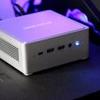Power Consumption / Accoustics
Power Consumption
We show energy consumption based on the entire PC (motherboard / processor / graphics card / memory / SSD). This number depends and will vary per motherboard (added ICs / controllers / wifi / Bluetooth) and PSU (efficiency). Keep in mind that we measure the ENTIRE PC, not just the processor's power consumption. Your average PC can differ from our numbers if you add optical drives, HDDs, soundcards etc.
Power consumption measurements will differ per PC and setup. Your attached components use power but your motherboard can also have additional ICs installed like an audio controller, 3rd party chips, network controllers, extra SATA controllers, extra USB controllers, and so on. These parts all consume power, so these results are a subjective indication
Below that, relative towards workload, the acoustics levels in decibels.
In the modern examination of Central Processing Units (CPUs), two principal power states are typically assessed - one of which is the PL2 state. The PL2 state allows the processor to access enhanced performance for brief periods, approximately 20 seconds. During this period, the processor can sustain heightened boost frequencies, albeit at the expense of increased energy consumption. In this particular situation, the processor peaks at 105 Watts.
Following this interval, both voltage and boost frequency self-adjust to lower levels, and the computer stabilizes around 64 Watts. It's noteworthy to mention that this processor is marketed with a Thermal Design Power (TDP) rating of 45 Watts. Thus, it is essential to understand the dynamics of these power states when evaluating CPU performance and energy efficiency.
A note on the integrated GPU performance, that's merely the GPU stress, not the processor.
Even in very heavy workloads, this mini PC does not make a lot of noise.



